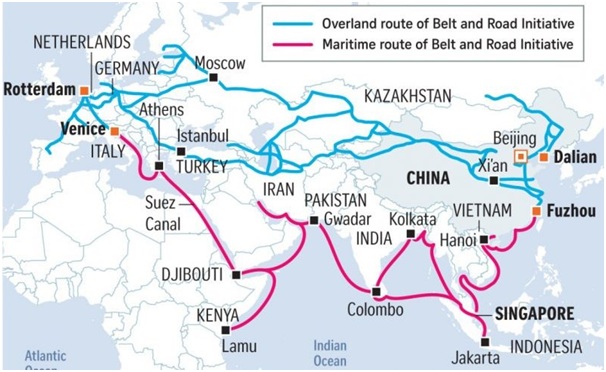

Context
The first shipment of the newly launched railway from the Myanmar border to the main commercialcentre in Chengdu in western China has been made recently.
About New Corridor
- The new trade corridor connects the lines of goods into Singapore, Myanmar and China, and is currently the best land and sea port linking the Indian Ocean to south-western China.
- China also has plans to build another port in Kyaukphyu in Rakhine state, Myanmar, including a proposed railway line from Yunnan (China) to the port, but progress has been halted by the Myanmar wars.
- China plans to develop the region in Myanmar as a place for ‘border economic cooperation’ under the Belt and Road Initiative (BRI).
- It is expected to be the mainstay of international trade with China, while providing a source of revenue for Myanmar.
- This trading post is another direct Chinese route to the Indian Ocean.
- The first to be at the port of Gwadar in Pakistan.
- This trade route is China's alternative to the "Malacca Dilemma".
- Malacca Dilemma is a name coined in 2003 by then-Chinese President Hu Jintao.
- This means China's fears of a sea embargo on the Straits of Malacca. As most of China's oil imports pass through the Straits of Malacca, a sea blockade here could cripple China's economy.
|
China's Belt and Road Initiative (BRI) What is BRI?
Pakistan and BRI:
|

China’s development plan on other ports
- About Gwadar Port:
- Gwadar is being developed as part of the CPEC in the remote and western region of Xinjiang.
- Gwadar has long been called the site of a Chinese base suitable for the operation of the People's Liberation Army Navy (PLAN).
- China is following the concept of "strength strategies" in which foreign strategies contain regional strategies for trade firms used by Chinese firms that could be used by their military.
- Such "strong points" provide an opportunity for China to build a network of supply, distribution and testing facilities near the Indian Ocean.
- This is called String of Pearls theory.
- Gwadar is important in China for three reasons:
- One to establish a direct link to the Indian Ocean via CPEC.
- The second factor is that Gwadar helps to strengthen or stabilize western China, a region where China feels threatened by the Islamic State.
- In addition, Gwadar is 400 kilometres from the main Hormuz Strait (linking the Persian Gulf with the Gulf of Oman to the Arabian Sea), where 40% of Chinese flow oil.
- What does China hope to achieve?
- China has both economic and economic reasons behind the plan.
- The country has promoted China's more powerful vision, while reducing growth and trade relations with the United States and pressuring the country's leadership to open new markets for its goods.
- Experts see the BRI as one of the main targets of the Chinese superpower under Xi, alongside a strategic economic development plan developed in Made in China 2025.
- The BRI also serves as a backlash against the much-anticipated "pivot to Asia", as well as China's approach to creating new investment opportunities, developing export markets, and boosting China's revenue and domestic consumption.
Results in India:
- China's economic stakes on the Bay of Bengal and on this new trade route show greater maritime presence and maritime involvement in the region which also strengthens the pearl policy by China.
- In addition to this trade route with China Pakistan Economic Corridor (CPEC), China is also planning the China-Nepal Economic Corridor (CNEC) which will link Tibet to Nepal.
- The end of the project will affect the boundaries of the Gangetic plain.
- So the three channels mean economic growth and strategic growth in China on the Indian subcontinent.
Conclusion
India has tried to convince countries that the BRI is a plan to dominate Asia, warning of what some analysts have called a “String of Pearls” geo-economic strategy whereby China creates unsustainable debt burdens for its Indian Ocean neighbours in order to seize control of regional choke points. However, New Delhi has long been unsettled by China’s decades-long embrace of its traditional rival, Pakistan.


